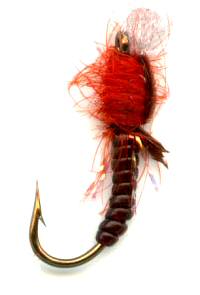Black Tufted Epoxy Buzzer Midge Nymph
The black tufted midge buzzer fly pattern is a good choice to use as part of a team of three nymphs fished under a strike indicator or large dry fly. During the early morning or late afternoon-evening nymphs rise towards the surface to hatch into adult dun mayflies

BUZZER MIDGE FLY PATTERNS. Hook size 12 14 16 18 20 24 - $US each
Hungry rainbow and brown trout are always on the lookout for these tiny insects moving up towards the water surface. When look for productive fishing locations on a summer visit to your local reservoir consider the dam wall. The predominate wind often slams into this large wall of concrete, bringing with it a concentration of floating spinners and terrestrials. As temperatures rise the deep cool water the dam wall area provides can be one of the best locations to find trout and grayling.
Other areas to fish are where a feeder stream or river enters the large area of still water. It brings with it fresh oxygen rich water which attracts them. The fish revel in these locations as they are also provide a source of food. The force of the water running in these water systems can dislodge nymphs, worms and carry drowning terrestrials like ants, grasshoppers and daddy longlegs into the lake or reservoir. Approach these locations stealthily. The trout and grayling will be looking towards the incoming water and bank for their next meal. If they see you they will disappear. Stay low and wear clothing that matches the color of the surrounding vegetation. Stand well back before making a few delicate casts into the margins.
Some of my stillwater lake and reservoir fly fishing mates think I am strange because they see me heading towards one of the bays at the end of the lake and start fishing into the strong wind using a 5lb weight set up. I do not have any problems as I am usually only casting my team of epoxy buzzers under a black gnat dry fly, a few yards along the bank to fish the trout mopping up midges, adult and pupae, that have been blown and trapped against the reeds.
On large stillwaters, the strong onshore winds create some large waves. Okay they are not surf-able but you know what I am talking about. Most of us have all been in a boat when a wave has splashed over the edge. The power in the waves can stir up invertebrates from the lake bottom and they are particularly disruptive near the edges.
Combine this with insects floating on the surface being blown towards the windward lake bankside and shores, these areas are an obvious fish food rich environment. The water is often stirred up and colored. The fish know where the best place to find their next meal is and you should look for these locations as well.
When fishing from a boat do not ignore the bank side hugging hungry rainbow and brown trout. Even if there is no or only a slight wind on the day you are fishing, look at the trees that surround water. Which way are they bending? They will indicate which way the prevailing wind blows. Go and fish the water edges where that wind would against. There will still be a bigger concentration of food in that area than other parts of the lake. You can also use the same knowledge to help you find more fish if you are casting from the land.
Many flyfishermen and women fail to approach the lake, reservoir, or river, with stealth and caution. If you spook a brown trout they will speed off into the nearest safe hidey-hole where they will wait until they feel it is safe again. Rainbow trout run for the center of the lake and find protection in its depths. The only exception I have found to this general rule is if the water has just recently been stocked with naive stew-fed trout who view the approach of a human as a signal that food will soon arrive.
A little unusual fishing tip that runs contrary to normal fly fishing advice is to make your cast land with splash when you have a lot of recently stocked fish in the lake. They associate a disturbance on the water surface with food being thrown into the water. They tend to home in on the origin of the vibrations they feel. These I consider easy fish to catch.
If I am with a newbie beginner fly-fisherman I let them loose on these types of trout before I introduce them to the harder to catch natives that need more skill to catch. This type of fishing is sometimes called stockie bashing. They are ideal to teach basic casting, line management and fly presentation in situations where even a mistake could still result in a fish.
The excitement of catching their first fish is enough to hook many people onto our sport. Compare this with a day trying to present flies to harder to catch fish that results in a blank day. They may feel they have wasted their time, it is too hard and never try again. Catching a few fish on their first day on the water fishing is a must, particularly if you are teaching youngsters.


